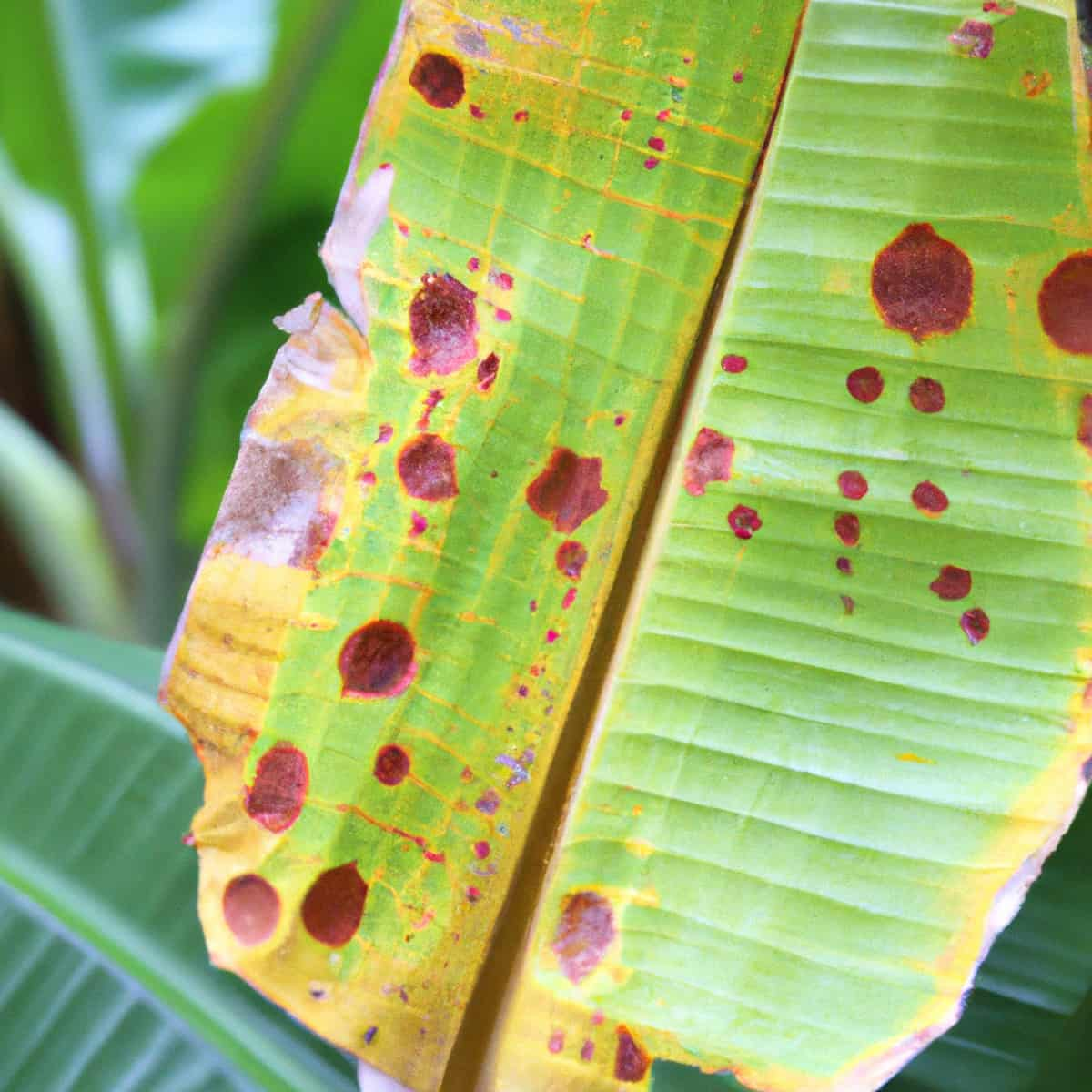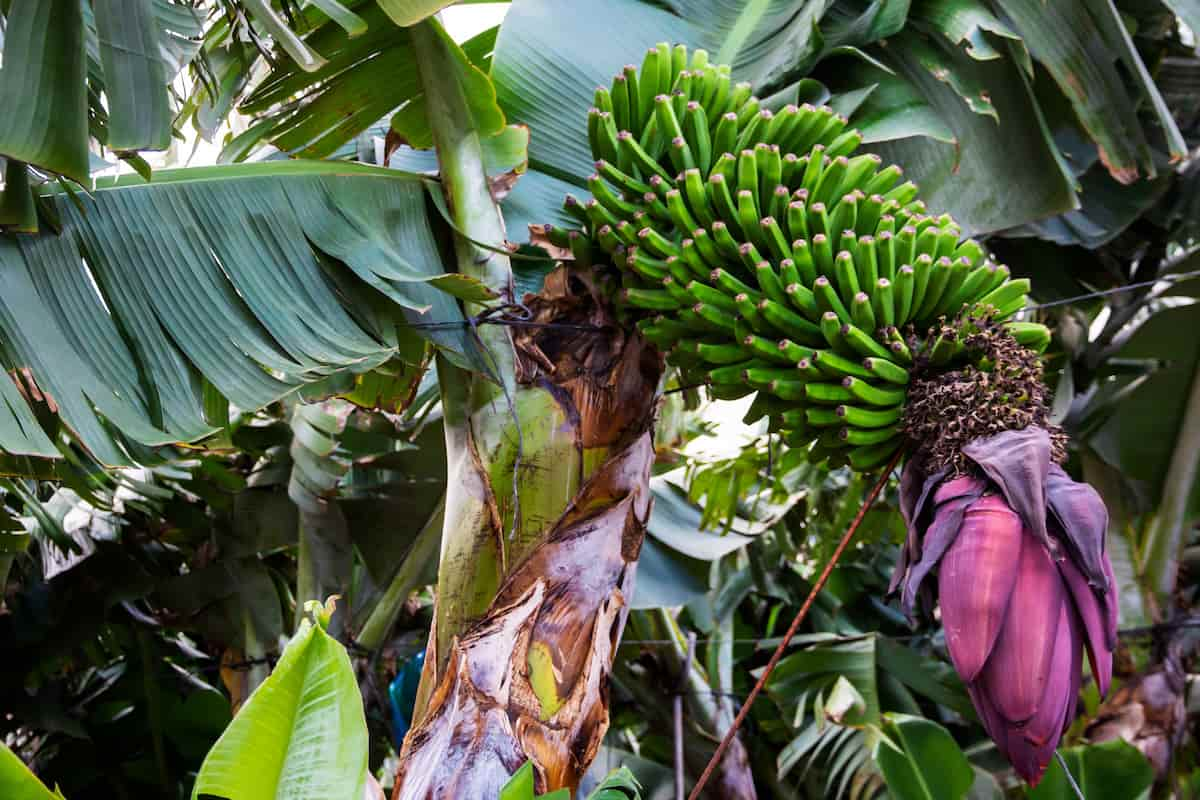The Banana Infectious Chlorosis Disease caused by the Banana Cucumber Mosaic Virus (CMV) is a severe disease affecting banana plants worldwide. The economic impact of Banana Infectious Chlorosis Disease is significant, as it reduces fruit yield, quality, and marketability and can result in the complete loss of yield. CMV is a highly infectious virus that can rapidly spread from infected plants to healthy ones through infected suckers or aphid insect vectors, making it challenging to control the spread of the virus.

In severe cases, Banana Infectious Chlorosis Disease can cause complete crop loss. To effectively manage this disease, it is important to understand its disease cycle, the mode of disease spread, and the best methods for controlling it. This article will provide an overview and discussion of the Banana Infectious Chlorosis Disease in Banana crops, including its symptoms, identification techniques, and control.
Banana Infectious Chlorosis Disease Management
The Causal Organism of Banana Infectious Chlorosis Disease
- Cucumber Mosaic Virus is a single-stranded RNA virus that belongs to the Family Bromoviridae of Order Martellivirales of the Phylum Kitrinoviricota.
- CMV is a highly infectious virus that can infect over 1,200 plant species. It was first reported in Taiwan in 1989.
- The virus replicates in the cytoplasm of the infected plant cells and causes severe damage to the host plant.
- CMV is transmitted through infected planting material, contaminated tools, vegetative propagation, insect vectors like melon aphids (Aphis gossypii & Aphis maidis), whiteflies, and thrips.
The Disease Cycle of Banana Infectious Chlorosis Disease
The disease cycle of the Banana Infectious Chlorosis Disease caused by CMV is complex and involves several steps. The disease cycle begins when an aphid vector feeds on an infected plant, acquiring the virus particles. The virus particles attach to the stylet of the aphid vector and are carried to healthy plants during feeding. Once the aphid vector acquires the virus, it can transmit it to healthy plants by probing and feeding.
The virus is transmitted non-persistent, meaning the virus particles are not retained in the vector’s body for an extended period. Once the virus is transmitted to a healthy plant, it replicates in the host plant’s cytoplasm. The virus hijacks the host plant’s cellular machinery to replicate and produce more virus particles. As the virus replicates in the host plant, it causes chlorotic mottling on leaves, stunted growth, and poor fruit quality, which are the symptoms of the disease.
The infected plants serve as a source of virus particles for aphid vectors to acquire and transmit to healthy plants, resulting in the secondary spread of the virus. The virus can also spread through infected plant material, contaminated tools, and soil. The virus can overwinter in infected plant debris, soil, and weeds, serving as a potential source of infection for the next growing season.
Occurrence of Banana Infectious Chlorosis Disease in Banana Crop
- Location of Banana Infectious Chlorosis disease: This disease occurs in Banana crops in India, Africa, China, Bangladesh, Sri Lanka, Thailand, Indonesia, Taiwan, Malaysia, the Philippines, the United States, Mexico, Brazil, Colombia, Ecuador, and Australia.
- Host range: The most common crops affected by CMV are Bananas, Cucumbers, Squash, Pumpkins, Watermelons, Cabbage, Broccoli, Cauliflower, Tomatoes, Peppers, Eggplants, Potatoes, Beans, Peas, Soybeans, Petunias, and Marigold.
Favorable Conditions for Banana Infectious Chlorosis Disease Spread in the Field
- CMV thrives in warm and humid conditions. It can survive and spread rapidly in areas ranging between 20°C to 30°C and with relative humidity above 80%.
- The virus prefers well-drained soils with high organic matter content.
- The virus is transmitted by insect vectors, primarily aphids, and secondarily by infected suckers.
- Weeds can host the banana aphid, providing shelter for the insect when banana crops are absent.
- The infection can occur through wounds in the plant tissue, such as those caused by pruning and insect pests.
- Poor sanitation measures can also contribute to the spread of the disease, such as using contaminated tools, equipment, and planting material.
In case you missed it: Banana Bunchy Top Disease Management: Symptoms, Treatment, Chemical, Biological, and Organic Control

Damage Symptoms of Banana Infectious Chlorosis Disease
- The disease is characterized by discontinuous yellow or chlorotic streaks, chlorotic mottling on leaves, stunted growth, and poor fruit quality and is transmitted by aphids.
- The clustering of leaves at the crown and stiffness in young leaves can be seen.
- The heart leaves and the central part of the pseudostem show heart-rot symptoms.
- The leaves do not grow completely and show a striped appearance, and the infected plants become dwarfs and show stunted growth.
Percentage of Yield Loss Due to Banana Infectious Chlorosis Disease in Banana Crop
- The disease can cause 30% yield losses in the United States. In Mexico, yield losses are 40%. In India, the yield losses are 50%. In Bangladesh, the losses are 40%. In Sri Lanka, the losses are 50%. In China, a 30% yield loss is seen. In Africa, yield losses are up to 50%.
- In Indonesia, it is 50%. In Taiwan, it is 30%. In Vietnam, it is 50%. In Ecuador, it is 40%. In the Philippines, it is 50%. In Malaysia, it is 40%. In Colombia, it is 50%. In Thailand, it is 40%. In Brazil, it is 40%. In Australia, the losses are 30%. The Economic Threshold Level is determined at around 10-20% yield loss.
Cultural Control Measures of Banana Infectious Chlorosis Disease
- Avoid intercropping the banana plants with cucumber, pumpkin, and other cucurbit plants since they act as alternative hosts for CMV.
- Removing and destroying infected plants in the early stages of the disease can prevent the spread of CMV to other plants.
- Adequate fertilization and irrigation can improve plant health and reduce the susceptibility of banana plants to CMV.
- Regular cleaning of tools and equipment is essential to prevent the spread of CMV.
- Farmers should also remove and destroy infected plant debris and weeds around the field to prevent the virus from persisting in the environment.
Biological Control Measures of Banana Infectious Chlorosis Disease
- Parasitic wasps lay their eggs inside the aphids, ultimately killing them and controlling the population of the CMV vector, the banana aphid.
- Some insects, such as ladybirds, lacewings, and predatory mites, are natural enemies of aphids that transmit the CMV virus.
- Entomopathogenic fungi, such as Beauveria bassiana, can infect and kill aphids.
Chemical Control Measures of Banana Infectious Chlorosis Disease
- Spray Methyl Demeton, Phosphomidon, Rogar, or Monocrotophos on the leaves of the plants to control the insect vectors like aphids, whiteflies, and thrips that transmit this virus.
- Plant Growth Regulators – PGRs, such as Salicylic acid and Benzothiadiazole, can stimulate the plant’s natural defense mechanisms against CMV.
Organic Control Measures of Banana Infectious Chlorosis Disease
- Pyrethrin is an insecticide extracted from the chrysanthemum flowers to control the CMV virus vectors.
- Biopesticides, such as Bacillus thuringiensis and Spinosad, can control aphid populations in banana plantations.
Preventive Measures for Control of Banana Infectious Chlorosis Disease
- Use only virus-free and certified suckers while planting new banana crops.
- Crop rotation with legumes can break the infection cycle and prevent the virus inoculum buildup in the soil.
- Regularly monitoring the crops for signs of disease will help to find and manage the disease early before it spreads.
In case you missed it: Banana Sigatoka Disease Management: Symptoms, Treatment, Chemical, Biological, and Organic Control

Conclusion
The Banana Infectious Chlorosis Disease caused by CMV is a serious viral disease and a major threat to banana production worldwide. The effective management of this disease requires an integrated disease management approach that involves a combination of measures such as certified virus-free planting material, sanitation, judicious use of insecticides, crop rotation, use of resistant cultivars, and monitoring and early detection. Implementing these measures can help prevent the disease’s spread and ensure the sustainability of banana production.
- Deworming Schedule for Dogs/Puppies: A Beginners Guide
- How to Prevent and Control Parasites in Goats
- Beneficial Insects in Pest Management
- Natural Solutions for Pest Control in Flower Gardens
- Types of Fungicides Used in Agriculture
- Common Issues in the Fruit Development Stage of Pomegranate Farming
- Fruit Development Issues in Papaya: Easy Solutions and Treatment
- Soil-Borne Diseases and How to Protect Your Plants
- Practices to Prevent Disease Spread in the Garden